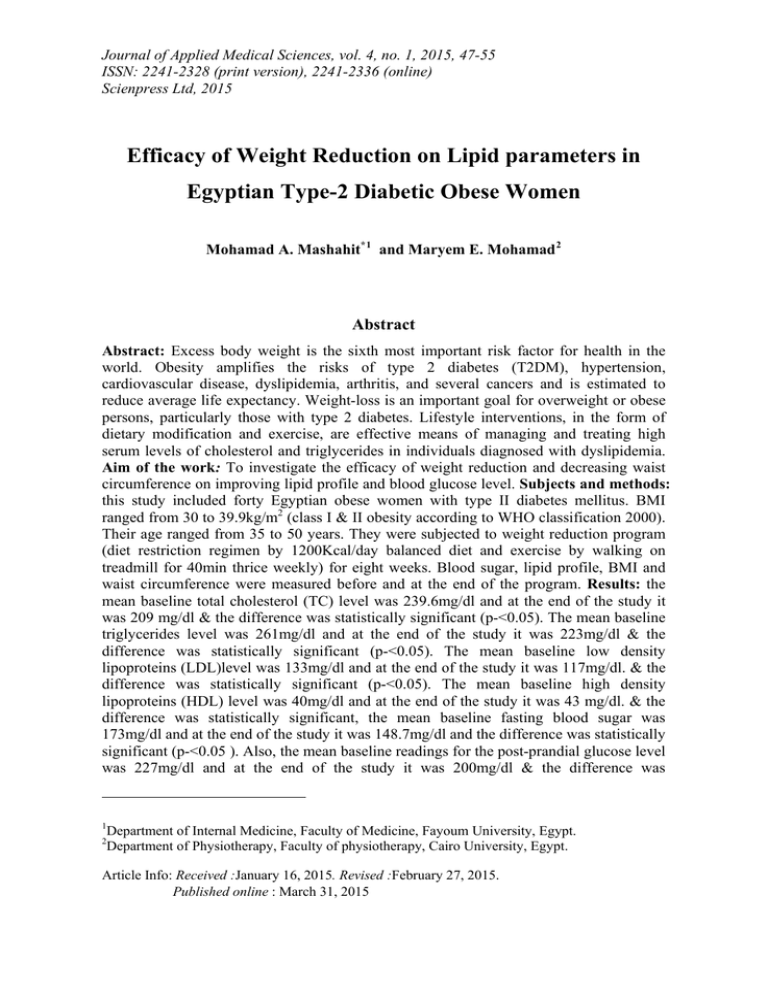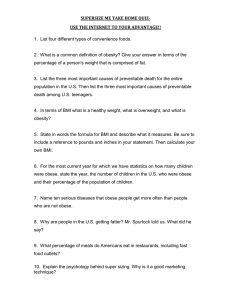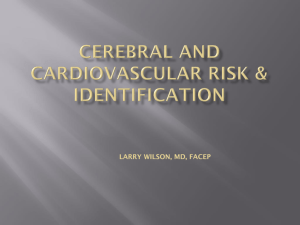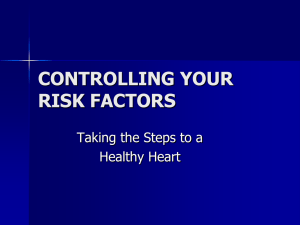Journal of Applied Medical Sciences, vol. 4, no. 1, 2015,... ISSN: 2241-2328 (print version), 2241-2336 (online)
advertisement

Journal of Applied Medical Sciences, vol. 4, no. 1, 2015, 47-55 ISSN: 2241-2328 (print version), 2241-2336 (online) Scienpress Ltd, 2015 Efficacy of Weight Reduction on Lipid parameters in Egyptian Type-2 Diabetic Obese Women Mohamad A. Mashahit*1 and Maryem E. Mohamad 2 Abstract Abstract: Excess body weight is the sixth most important risk factor for health in the world. Obesity amplifies the risks of type 2 diabetes (T2DM), hypertension, cardiovascular disease, dyslipidemia, arthritis, and several cancers and is estimated to reduce average life expectancy. Weight-loss is an important goal for overweight or obese persons, particularly those with type 2 diabetes. Lifestyle interventions, in the form of dietary modification and exercise, are effective means of managing and treating high serum levels of cholesterol and triglycerides in individuals diagnosed with dyslipidemia. Aim of the work: To investigate the efficacy of weight reduction and decreasing waist circumference on improving lipid profile and blood glucose level. Subjects and methods: this study included forty Egyptian obese women with type II diabetes mellitus. BMI ranged from 30 to 39.9kg/m2 (class I & II obesity according to WHO classification 2000). Their age ranged from 35 to 50 years. They were subjected to weight reduction program (diet restriction regimen by 1200Kcal/day balanced diet and exercise by walking on treadmill for 40min thrice weekly) for eight weeks. Blood sugar, lipid profile, BMI and waist circumference were measured before and at the end of the program. Results: the mean baseline total cholesterol (TC) level was 239.6mg/dl and at the end of the study it was 209 mg/dl & the difference was statistically significant (p-<0.05). The mean baseline triglycerides level was 261mg/dl and at the end of the study it was 223mg/dl & the difference was statistically significant (p-<0.05). The mean baseline low density lipoproteins (LDL)level was 133mg/dl and at the end of the study it was 117mg/dl. & the difference was statistically significant (p-<0.05). The mean baseline high density lipoproteins (HDL) level was 40mg/dl and at the end of the study it was 43 mg/dl. & the difference was statistically significant, the mean baseline fasting blood sugar was 173mg/dl and at the end of the study it was 148.7mg/dl and the difference was statistically significant (p-<0.05 ). Also, the mean baseline readings for the post-prandial glucose level was 227mg/dl and at the end of the study it was 200mg/dl & the difference was 1 2 Department of Internal Medicine, Faculty of Medicine, Fayoum University, Egypt. Department of Physiotherapy, Faculty of physiotherapy, Cairo University, Egypt. Article Info: Received :January 16, 2015. Revised :February 27, 2015. Published online : March 31, 2015 48 Mohamad A. Mashahit and Maryem E. Mohamad statistically significant (p-<0.05). Also, the mean baseline readings for HbA1c was 8.4±0.56 gm% and at the end of the study it was 7.8±0.49 gm %& the difference was statistically significant (p-<0.05) There was no significant differences for the effect of weight reduction on dyslipidemia between class I and class II obesity groups exceptionally here was a significant difference in the effect of weight reduction on the 2HPP blood sugar between the two groups. Conclusion: This study demonstrated that the diet regimen and the exercise program that were applied in our study had a significant effect in weight and waist circumference reduction, which resulted in a significant decrease in blood sugar, total cholesterol, LDL and triglycerides and significant increase in HDL. There was no significant difference in the effect of weight reduction on dyslipidemia between class I and class II obesity groups. While there was a significant difference in the effect of weight reduction on the 2HPP blood sugar between the groups. Keywords: Obese, diabetes, exercise diet, dyslipidemia. 1 Introduction Over 300 million people have been diagnosed with type 2 diabetes Worldwide. National Health and Nutrition Examination Survey (NHANES) showed that among individuals with diabetes, 85% will be overweight or obese [1, 2]. The prevalence of obesity is increasing worldwide at an alarming rate in both developed and developing countries European obesity prevalence range from 10 to 20% in men and 15 to 25% in women, whereas the prevalence of obesity among U.S. adults has reached 28% in men and 34% in women. In Egypt, 18.2% of males and 39.5% of females are obese [3, 4]. Excess body weight is the sixth most important risk factor contributing to the health burden of the world. Obesity amplifies the risks of type 2 diabetes (T2DM), hypertension, cardiovascular disease, dyslipidemia, arthritis, and several cancers and is estimated to reduce average life expectancy [5]. Available prospective cohort studies suggest that lipid abnormalities are associated with increased risk of cardiovascular events in patients both with and without diabetes. Various studies have demonstrated that LDL, HDL, and triglycerides are independent predictors of CVD [6]. In patients with T2DM, low levels of high density lipoprotein cholesterol (HDL-C) have been found to be an independent predictor of risk for coronary heart disease (CHD) even when low density lipoprotein cholesterol (LDL-C) levels are low and therefore can be a greater risk factor than high levels of LDL-C [7, 8]. Diet and exercise are the fundamental and first considerations in patients with Type2 diabetes mellitus (T2DM). They should constitute the starting point of physicians' conversations with these patients to provide guidance and instructions about a diet constructed to avoid complications of diabetes mellitus and limit dyslipidemia [9]. A plethora of epidemiologic evidence from large studies supports unequivocally an inverse, independent, and graded association between volume of physical activity, health, and cardiovascular and overall mortality. This association is evident in apparently healthy individuals, patients with hypertension, type 2 diabetes mellitus, and cardiovascular disease, regardless of body weight. Moreover, the degree of risk associated with physical inactivity is similar to, and in some cases even stronger than, the more traditional cardiovascular risk factors. The exercise-induced health benefits are in part related to favorable modulations of cardiovascular risk factors observed by increased physical Efficacy of Weight Reduction on Lipid parameters in Type-2 Diabetic Obese Women 49 activity or structured exercise programs. Although the independent contribution of the exercise components, intensity, duration, and frequency to the reduction of mortality risk is not clear, it is well accepted that an exercise volume threshold defined at caloric expenditure of approximately 1,000 Kcal per week appears to be necessary for significant reduction in mortality risk. Further reductions in risk are observed with higher volumes of energy expenditure [10]. 2 Aim of the Work The aim of this work is to investigate the efficacy of weight reduction and decreasing waist circumference on improving lipid profile and blood glucose level. 3 Subjects and Methods This study included 40 volunteer type -2 obese women , Their BMI ranged from 30 to 39.9 kg/m² (class I & II obesity according to WHO classification 2000) participated in this study for 12 weeks. The patients were divided into two equal classes: class I: included 20 diabetic obese women (BMI:30-34.9) and class II: included 20 diabetic obese women (BMI:35-39.9). The mean age of the participants was 38±3.5 years and the mean duration of diabetes is 4±1.3 years. All the patients received the same weight reduction program and continued on their medications . Weight and height scale (Weighting Bazange scale, with max. weight 160kg, max. height 2 meters and made in china), to detect weight and height for body and Walking treadmill (MF8608F treadmill fitness, made in china) to perform the exercise program. The vital signs (Heart rate, Respiratory rate, Blood pressure) were examined to exclude any signs or symptoms that may interfere with the continuity of the study .Blood pressure was measured while the subject was in a complete physical and mental rest before each session. Body mass index will be calculated by weight in Kg/m2.Waist circumference: Waist was defined as the smallest circumference of the torso midway between the inferior margin of the 12th rib and the iliac crest in a horizontal plane, Waist circumference was measured while the subject was standing, feet 25 to 30 cm apart, and when evenly distributed, with a no stretchable tape measure, a snug fit that does not compress soft tissues was applied. Also blood samples were taken for measuring the fasting and postprandial glucose levels, the HbA1c , Serum total cholesterol, High-density lipoproteins, Low-density, lipoproteins and triglycerides (after 12h fast) before starting and at the end of the program. Both groups were subjected to weight reduction program (diet restriction and exercise) to reduce their weight. Such restricted diet provided about 1200 kcal / day and divided into 3 meals and 2 small meals (snacks). A diet, in which fruits, non-starch vegetables, one dairy product was emphasized. All the procedure details were explained for each patient and all women participated in this study attended the program of walking exercise and treadmill three times weekly for 12 weeks . The Duration of each session lasted for forty min.; the first ten minutes of each session dedicated to warming up exercise on the treadmill with slow speed or intensity and the same for the cooling down phase for 10 min also. There was a twenty minutes for conditioning exercise (active phase). 50 Mohamad A. Mashahit and Maryem E. Mohamad 4 Statistical Analysis Collected data were computerized and analyzed using Statistical Package for Social Science (SPSS) version 16. Descriptive statistics were used to describe variables; percent, proportion for qualitative variables. Mean ± SD and range for Quantitative variables. Student’s t-test was used to compare the normally distributed continuous variable between the patients with aortic valve stenosis and the healthy control group. Fisher-exact test and Chi-square test were used to compare categorical variables. P values with significance of less than 5% were considered statistically significant. For all statistical tests, a P value less than 0.05 was used to indicate significance. 5 Results This study included 40 volunteer type -2 obese women, Their BMI ranged from 30 to 39.9 kg/m² (class I & II obesity according to WHO classification 2000) participated in this study for 12 weeks. The patients were divided into two equal classes: class I: included 20 diabetic obese women (BMI:30-34.9) and class II: included 20 diabetic obese women (BMI:35-39.9). The mean age of the participants was 38±3.5 years and the mean duration of diabetes is 4±1.3 years. All the patients received the same weight reduction program and continued on their medications .Our patients showed significant reduction of both BMI and waist circumference (W.C.) after the intervention.(Table 1) Table 1: Effect of exercise and diet regimen on BMI & Waist circumference. Class 1 Class 2 before after BMI (kg/m2) 33.7±3 30.1±1.1 Waist circumference(cm) 99.2±4. 94.2±4. p-value 0.02 0.03 p-value before after 38.3±1.9 33.3±1.3 104.3±5. 98.3±5.1 0.03 0.04 Table 2: Effect of weight reduction on lipid parameters Total cholesterol (mg/dl) Triglycerides (mg/dl) Before Mean± S.D 239.6±22.1 261.7±43.5 After Mean± S.D 208.9±19.2 223.2±38.5 LDL (mg/dl) 133.4±23. 117. 9±1 0.04 0.05 0.04 HDL(mg/dl) FBS (mg/dl) PP-BS (mg/dl) HbA1c (gm %) 40.1±2.4 172.9±25.5 227.3±37.3 8.4±0.56 43.1±2.8 148.7±22.5 199.6±30.1 7.8±0.49 0.04 0.04 0.05 0.07 Parameter p-value The mean baseline total cholesterol level was 239.6mg/dl while at the end of the study it was 209mg/dl and the differences were statistically significant ( p < 0.05 ). The mean Efficacy of Weight Reduction on Lipid parameters in Type-2 Diabetic Obese Women 51 baseline triglycerides level was 261mg/dl while at the end of the study it was 223mg/dl and the differences were statistically significant ( p < 0.05 ). The mean baseline low density lipoproteins level was 133mg/dl while at the end of the study it was 117mg/dl and the differences were statistically significant( p < 0.05 ).The mean baseline high density lipoproteins level was 40mg/dl while at the end of the study it was 43mg/dl and the differences were statistically significant ( p < 0.05 ) table-2 . Regarding the effect of weight reduction on lipid parameters in class I and class II obesity, class I had a total cholesterol level reduction by 13.5% and class II had a reduction by 12%, with no significant difference between the two groups. 250 200 230.2 249.1 198.5 150 218.195 Cholest Before 100 Cholest After 50 0 Class I Class II Figure 1: Comparison between class I and II obesity regarding the weight reduction effect on total cholesterol It was also found that Class I had a triglycerides level reduction by 14% while class II had a reduction by 15.5%. Also, with no significant difference between the two groups. Class I had a low density lipoproteins level reduction by 12.3% while class II had a weight reduction by 10.9%, with no significant difference between the two groups. Figure 2: Comparison between class I and II regarding weight reduction effect on LDL In this study, Class I had a high density lipoproteins level increase by 7.2% while class II had an increase by 5.8%, with no significant difference between the two groups. 52 Mohamad A. Mashahit and Maryem E. Mohamad 44 43.35 42.8 43 42 40.95 41 40 HDL Before HDL After 39.9 39 38 Class I Class II Figure 3: Comparison between class I and II regarding weight reduction effect on HDL Finally we concluded that there was no significant differences in the effect of weight reduction on dyslipidemia between class I and class II obesity. Regarding the effect of weight reduction on blood sugar levels: (table 2) In this study The mean baseline fasting blood sugar was 173mg/dl while after the intervention it decreased to 148.7mg/dl and the differences were statistically significant ( p < 0.05 ). Also, the mean baseline two hours post-prandial glucose level was 227mg/dl while after the intervention it was 200mg/dl & the differences were statistically significant ( p < 0.05 ) Also, the baseline mean readings for HbA1c was 8.4±0.56 gm% while after the intervention it was 7.8±0.49 gm %& the difference was statistically insignificant. In this study . patients with BMI from 30 to < 35 (Class I) had a fasting blood sugar level reduction by 1.56% while patients with BMI from 35 to 40 (class II ) had a reduction by 1.24%,%, and the differences between both groups were not statistically significant Efficacy of Weight Reduction on Lipid parameters in Type-2 Diabetic Obese Women 200 150 53 178 155.9 167.85 141.65 100 50 Figure 4: Comparison between class I and II regarding weight reduction effect on blood sugar level Also it was found that Class I had a two hours post prandial glucose level reduction by 14.5% while class II had a reduction by 10% with significant difference ( p<0.05) 230 229.65 225 220 207.05 210 200 192.2 2HPP Before 2HPP After 190 180 170 Class I Class II Figure 5: Comparison between class I and II regarding weight reduction effect on 2HPP So according to the degree of obesity , There was no significant difference for the effect of weight reduction on dyslipidemia between class I (BMI 30-< 35 )and class II (BMI 35 to 40 ) obesity groups. While there was a significant difference in the effect of weight reduction on the 2HPP blood sugar between the two groups. 6 Discussion The most consistent findings from epidemiologic studies and randomized controlled trials supports that aerobic exercise of adequate intensity, duration, and volume results in favorable and independent alterations in high-density lipoprotein (HDL) cholesterol, with less consistency for reductions in total cholesterol, triglycerides, and low-density 54 Mohamad A. Mashahit and Maryem E. Mohamad lipoprotein cholesterol concentrations for both normolipidemic and dyslipidemic individuals. Exercise training can also attenuate the reductions in HDL cholesterol usually observed with low-fat diets. Overall, no consistent evidence is available to indicate that HDL cholesterol changes related to exercise are associated with age, ethnicity, or gender [10]. The current study showed significant reduction of BMI and waist circumference in both groups at the end of the program. We found that there was significant improvement in dyslipidemia as regard its four parameters. There was significant reduction in total cholesterol, LDL-cholesterol and triglyceride levels. Also, there was significant increase of HDL-cholesterol level in both groups. Our findings are in agreement with recent studies. Nielsen et al in 2012 [11] showed that dyslipidemia improved significantly with weight loss; the odds ratio (OR) was 0.37 per BMI (p = 0.014) after adjusting for age, sex, and baseline BMI. Baseline triglycerides concentration correlated positively and HDL concentration correlated negatively with baseline BMI . Weight loss was associated with a decrease in the concentrations of total cholesterol (p = 0.0005), LDL (p < 0.0001), non-HDL (p < 0.0001), and TGs (p < 0.0001), and with an increase in HDL concentration (p < 0.0001). Krauss et al in 2006 [12] investigated the effect of low carbohydrate diet with weight reduction on the lipoprotein levels. They concluded that the 26%-carbohydrate, low-saturated-fat diet reduced triacylglycerol, apolipoprotein B, small LDL mass, and total: HDL cholesterol. These changes were significantly different from those with the 54%-carbohydrate diet. After subsequent weight loss, the changes in all these variables were significantly greater and the reduction in LDL cholesterol was significantly greater with the 54%-carbohydrate diet than with the 26%- carbohydrate diet. With the 26%-carbohydrate diet, lipoprotein changes with the higher saturated fat intakes were not significantly different from those with the lower saturated fat intakes, except for LDL cholesterol, which decreased less with the higher saturated fat intake because of an increase in mass of large LDL. However, in our study we prescribed low calorie balanced diet that showed comparable results to those with 54%- carbohydrate diet in their study. American Diabetes Association in 2005 [13] recommended that weight loss and increased physical activity will lead to decreased triglycerides and increased HDL cholesterol levels and also to modest lowering of LDL cholesterol levels. Patients with diabetes who are overweight should be given a prescription for medical nutrition therapy (MNT) and for increased physical activity. Recommendations of the American Heart Association for patients with CVD have suggested that the maximal MNT typically reduces LDL cholesterol 15–25mg/dl. Our study followed these recommendations in a simple way by low calorie balanced diet and walking exercise for eight weeks duration and our results were significant as regard blood sugar control and dyslipidemia management. This enables us to design a suitable program that can be applied to Egyptian diabetic obese women. 7 Conclusion This study demonstrated that the diet regimen and the exercise program that were applied in our study had a significant effect in weight and waist circumference reduction, which resulted in a significant decrease in blood sugar, total cholesterol, LDL and triglycerides Efficacy of Weight Reduction on Lipid parameters in Type-2 Diabetic Obese Women 55 and significant increase in HDL. There was no significant difference in the effect of weight reduction on dyslipidemia between class I and class II obesity groups. While there was a significant difference in the effect of weight reduction on the 2HPP blood sugar between the groups. 8 References [1] [2] [3] [4] [5] [6] [7] [8] [9] [10] [11] [12] [13] K.L.T. Borch, Screening for type 2 diabetes: should it be now? Diabet Med (2003). M.W. Morb, Centers for Disease Control and Prevention (CDC) Prevalence of overweight and obesity among adults with diagnosed diabetes: Rep 53(2004); :1066–1068. World Health Organization: 'Obesity and overweight', Fact sheet N°311 Updated March (2011). World Health Organization (2012): Obesity Situation and trends, Global Health Observatory (GHO). World Health Organization. Technical report series 894: Obesity: Preventing and managing the global epidemic.. Geneva: World Health Organization. 5: (2000) 92-94. R.C. Turner, H. Millns, H.A. Neil, I.M. Stratton, S.E. Manley, D.R. Matthews, R.R. Holman. Risk factors for coronary artery disease in non-insulin dependent diabetes mellitus (UKPDS 23). BMJ 316: (1998) 823–828. W.H. Geneva, D.W. Haslam and W.P. James. Report of a WHO Consultation.: Obesity. Lancet ;366: (2005)1197–1209 W.P. Castelli. Cholesterol and lipids in the risk of coronary artery disease. The Framingham Heart Study. Can J Cardiol;4(suppl A) (1998)5A-10A. K.H. Lalita, C.M. Sue, and M.A.Caroline Treating Diabetes and Pre-diabetes by Focusing on Obesity Management. Curr Diab Rep.; October ; 9(5): (2009) 348–354. P. Kokkinos. Physical Activity, Health Benefits, and Mortality Risk. ISRN Cardiology (2012), Article ID 718789 T.R. Nielsen, M. Gamborg, C.E. Fonvig, J. Kloppenborg, K.N. Hvidt, H. Ibsen, J.C. Holm. Changes in lipidemia during chronic care treatment of childhood obesity. Child Obes. Dec; 8(6) (2012) 533-41. doi: 10.1089/chi.2011.0098. M. Krauss, J. Blanche, S. Rawlings, S. Fernstrom, and T. Williams. Separate effects of reduced carbohydrate intake and weight loss on atherogenic dyslipidemia. Am J Clin Nutr; 83: (2006) 1025–31. American Diabetes Association, North American Association for the Study of Obesity, American Society for Clinical Nutrition; Weight Management Using Lifestyle. Modification in the Prevention and Management of Type 2 Diabetes: Rationale and Strategies. Clinical Diabetes 23(3): (2005) 130-136.





